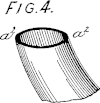UNITED STATES PATENT OFFICE.
FREDERICK REAST, OF HASTINGS, ENGLAND, ASSIGNOR TO WALTER HUBBARD, OF SAME PLACE.
Shoulder-brace Corset.
SPECIFICATION forming part of Letters Patent No. 433,095, dated July 29, 1890. Application filed April 22, 1890. Serial No. 349,054, (No model.) Patented in England July 1, 1887, No. 9,368, and in France March 23, 1889, No. 196,922.
To all whom it may concern:
Be it known that I, FREDERICK REAST, a subject of the Queen of England, residing at Hastings, in the county of Susses, England, have invented certain new and useful Improvements in Corsets, (for which I have obtained British Letters Patent No. 9,368, dated July 1, 1887, and French Letters Patent were granted to Walter Hubbard, No. 196,922, dated March 23, 1889,) of which the following is a specification.
This invention relates to improvements in the construction of corsets or stays for women, men, and children, and has for its objects to afford support to the back of the wearer, to keep the figure erect, and to expand the chest, and to a great extent to prevent tight lacing.
In the accompanying drawings, Figure 1 is a perspective elevation of the back of a corset intended for women. Fig. 2 is an extended view of stays adapted for men and boys, drawn in full lines, and superimposed thereon is shown by dotted lines an extension thereof to make it suitable for women and girls, and Figs. 3 and 4 are detailed views of that portion of the shoulder-straps that pass under the arms.
In carrying out this invention the, back portion of the corsets, denoted by A and A' in Fig. 1, are prolonged to form shoulderstraps a and a', of gradually-decreasing width, and of such length as to terminate under the arms, so that the extremities thereof may be secured in position by buckles b b', attached to short strips of elastic webbing c c', sewed to the shoulder-straps. The shoulder-strap a on the right crosses and overlaps the strap a' and passes over the right shoulder, while the left strap a' crosses beneath and is overlapped by the strap a, and passes over the left shoulder.
At the free extremity of each of the straps a a' are short lengths of elastic webbing d d', which respectively engage with the buckles b b'. The object of inserting these lengths of elastic material c c' and d d' is to allow free use of the arms, as the webbing yields to every movement thereof. The shoulder-straps are in part stiffened by bones or steels h h' fitted in pockets formed in the straps.
Loops or supports j j' are stitched at one end to the corset A and A', and at the other end to the strap a a' and through these shoulder-straps are passed and supported thereby. It will be seen that the lacing at the bach of the corset is not continued upward the entire height, but only about the lower half, as the shoulder-straps answer the purpose of lacing for the upper portion of the corset with greater advantage.
Fig. 2 represents by full lines stays adapted for men and boys. In this the bosom or front portion of the corset is dispensed with, but the shoulder-straps a and a' are carried across and over the shoulder, a5 described for Fig. 1, and are secured in position by the buckles b and b' engaging with the free and elastic ends d and d'. The back portions of the corset A and A' are in this instance prolonged to form a girth k, and secured around the waist by a buckle m. When this kind of corset is to be used by females, front or bosom portions are provided, as shown by the dotted lines of Fig. 2, and furnished with long or short busks, as reguired. Bones or steels f f' are inserted for stiffening purposes.
To prevent the straps a a' twisting into a string and hurting the wearer, I insert a short piece of elastic tubing a2 at the part passing beneath the arms, as shown in Figs. 1 and 2. This tubing may take the form of two small pipings a5 a5, inserted along the edges of the fabric a3 and stitched in along the lines a4 as shown in Fig. 3.
Fig. 4 is an enlarged view of the tubing sewed to the fabric, and indicated by a2 a2 in Figs. 1 and 2.
Having fully described my invention, what I claim, au d desire to be see ured by Letters Patent is--
As a new article of manufacture, a corset having diagonally crossing and overlapping shoulder-straps with supporting-loops, one end of each loop being attached to the back of the corset and the other end to a shoulder-strap, a twist-resisting flexible tubing attached to each shoulder-strap at the point situated beneath the arms of the wearer, an elastic webbing and securing-buckle attachment to the shoulder-strap near the back, and a short length of lacing on the lower portion of the back of the corset, substantially as and for the purpose set forth.
In testimony whereof I have signed this specification in the presence of two subscribing witnesses.
FREDERICK REAST.
Witnesses:
ARTHUR CHAPMAN,
Solicitor's Articled Clerk, 35 Cambridge Gardens, Hastings, Sussex, England.
W. STANDEN,
Solicitor's Clerk, 3 Portland Terrace, Hast-ings, Sussex, England.
This work was published before January 1, 1929, and is in the public domain worldwide because the author died at least 100 years ago.
Public domainPublic domainfalsefalse



